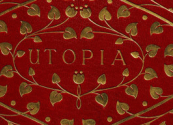Secondary Source: “Candide Shoots the Monkey Lovers: Representing Black Men in Eighteenth-Century Visual Culture”
by Sophia Natasha Sunseri
Bellhouse, Mary. “Candide Shoots the Monkey Lovers: Representing Black Men in Eighteenth-Century French Visual Culture.” Political Theory 34.6 (2006). 741-784.
In this reading, Bellhouse explores the visual construction of black male identity in France during the long eighteenth century. She conveys how European perceptions of black men changed drastically after the Haitian Revolution of 1791, in which slaves rebelled against their owners. Prior to the Revolution, artists often depicted black men as inferior and child-like whereas after, they depicted them as violent and virile. Bellhouse delves deeper into this distinction by comparing two sets of illustrations of Voltaire’s Candide, which were both drawn by Jean-Michael Moreau. The first set was composed before the revolution, in 1787, and the second was composed after, in 1803. The differences that emerge between the two ultimately reflect a growing cultural anxiety about interracial relations between Europeans and blacks during this time.
From the late seventeenth century until 1789, black men were portrayed as emasculated in French visual culture. When they appeared in paintings and illustrations, they often embodied one of two roles: exotic servants in metropolitan France or plantation slaves in the colonies. It was not uncommon for them to be depicted as infantilized, servile, or maimed. Atoine Coypel’s painting, Young Black Holding a Basket of Fruit and a Young Woman Stroking a Dog (1682) is a prime example. In this work, a sumptuously attired dark skinned boy dons a white turban adorned with feathers, emphasizing his otherness. The black man-as-child was thus presented as relatively harmless: he was not yet regarded as sexually threatening “and the emergent taboo of the black man and white woman [was] avoided” (744).
After the 1790s, however, portrayals of black men as inferior and dependent were replaced by images of black men as violent and sexually threatening. Such images included: “oversized genitalia” as well as depictions of black men as “…armed attacker[s] …and bestial rapist[s] who chase after white women” (742). This shift in visual representation can be attributed to cultural anxiety that came about as a byproduct of the Haitian Revolution. The uprising resulted in many horrific atrocities, news of which eventually made its way to Europe. Anxiety increased in France as reports of black men raping white women circulated.
The change in the way in which black men were visually represented is exemplified in Moreau’s illustrations of Candide.
Moreau’s 1787 illustrations depict black men as non-threatening. One scene that Moreau chose to portray is the episode in Chapter 19 when Candide and Cacambo visit Surinam and encounter a maimed slave. Moreau’s illustration endows Candide with several phallic artifacts suggesting masculine prowess: a walking stick, a rifle, upright legs. The slave, by contrast, is lying down horizontally in the shadows, his peg leg and crutch visible. As Bellhouse surmises: “In Moreau’s illustrations, light skin colour is linked to multiple signifiers of ‘phallic’ power, while dark skin is linked to dismemberment” (758).
Moreau’s 1803 illustrations are markedly more violent than his 1787 illustrations. In one of them, Candide is shown navigating his way through a field of white bodies that have been scorched, raped, and disemboweled.
Of particular interest to Bellhouse, however, is the scene in which Candide shoots the Monkey Lovers. Here, Moreau revises aspects of Voltaire’s narrative. In Voltaire’s text from 1759, Candide risks being cannibalized but in Moreau’s illustration from 1803, he is portrayed as saving the young women from immanent danger. Moreau’s depiction of skin colour and European facial features were also decisions of his own making. Rather than depict the “naked girls” as indigenous, as Voltaire does, Moreau depicts them as European-looking. He also makes the monkeys appear especially menacing—an interpretation that sharply juxtaposes earlier illustrations by artists such as Charles Monnet whose 1776 illustrations portray the monkeys’ faces as “benign” (774). Monnet’s monkeys are “pictured with prominent tails, [that] look like toys. One monkey is almost smiling” (776). Interestingly, Moreau’s monkeys from the 1803 illustrations are given darker fur than the monkeys in his 1787 set and are drawn to look more muscular. By the time in which Moreau selected the monkey scene for illustration, debates about cross-species breeding had been complicated by intensifying anxiety about interracial sexuality and by years of war in what is now Haiti. The mixing of races in Haiti produced many contentious and heated debates, which are made apparent in comparing Moreau’s two sets of illustrations.


